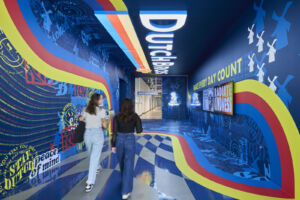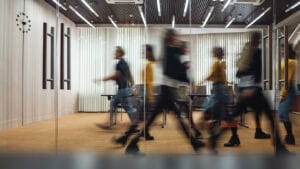Previously, most offices weren’t designed for humans. They embodied cubicle grids, 9-to-5 rigidity, and people pretending to enjoy breakroom coffee.
Times have changed, and so should your workspace.
In an age where employee wellness, flexibility, and accessibility drive productivity, the modern office does more than look good. It has to feel good, too.
The era of real-life workspaces should be built for people with bad backs, good ideas, occasional toddler pick-ups, and a need for natural light.
Here’s how to create a workplace your employees won’t just tolerate but love.
LOCAL NEWS: 100 best places to work and live in Arizona for 2025
INDUSTRY INSIGHTS: Want more news like this? Get our free newsletter here
Start with People in Mind
Designing for wellness goes beyond ergonomic chairs or a succulent on every desk (although we fully support both).
Acknowledge that people are whole humans, with bodies, emotions, and lives that extend outside the office.
Facility Executive explains that occupant wellness should be at the core of design, not an afterthought.
This includes temperature control, access to natural light, acoustic comfort, and air quality. When these basics are overlooked, so is your team’s potential.
And it’s not only about physical comfort. Spaces for quiet reflection and spontaneous collaboration can encourage psychological well-being and reduce stress.
Bottom line? You can’t expect innovation in a space that feels like a dentist’s waiting room.
Accessibility Isn’t Optional
We’re in 2025. If your office isn’t accessible, it’s bad business.
Accessibility includes wheelchair access, of course. However, it also means designing with neurodivergence, visual and auditory needs, and pregnancy accommodations in mind.
Pregnancy discrimination is real. Enter the Pregnant Workers Fairness Act (PWFA). The federal law requires businesses to provide “reasonable accommodations” for pregnant employees, like schedule flexibility, closer parking, and modified work duties.
Besides compliance, these adjustments indicate that your workplace respects life’s full journey. Conn Maciel Carey adds that the PWFA applies to pregnant and postpartum workers and related medical conditions.
In other words? Don’t think you’re off the hook because you run a medium-sized company.
Easy Fixes That Go a Long Way
You don’t need to get your office or commission a celebrity architect to make meaningful changes.
Some of the most effective updates are surprisingly simple and affordable. Crown Workspace recommends easy wins like:
- Swapping harsh lighting for warm, natural options
- Creating quiet ‘focus zones’ away from high-traffic areas
- Adding plants to reduce stress and boost oxygen
- Updating shared spaces with better chairs and flexible furniture
- Introducing scent diffusers or soft music in common areas
Little touches like these show employees you care and that their comfort isn’t an afterthought.
Design for Flexibility, Not Fantasy
The majority of teams today aren’t all-in or all-out but somewhere in between.
So your office should support a hybrid model. Think less “open plan for the masses,” more “choose-your-own-adventure workspace.”
Dezeen explores the unsettling design of the ‘Severance’ (yes, that eerie Apple TV show)workspace and how deeply it impacts the way people feel and behave.
Cold, generic layouts alienate people. Personalized, flexible spaces invite creativity. Create a variety of zones:
- Collaborative areas for team brainstorming
- Private booths for deep focus
- Lounge-style seating for casual convos
- Tech-enabled rooms for virtual meetings
This variety complements different working styles, helping everyone find their groove.
Culture Is Built Into the Floor Plan
A well-designed space reinforces your values without a single PowerPoint slide.
For instance, if collaboration is key to your brand, open walkways and communal tables send a clear message.
Add standing desks, meditation nooks, or lunchtime yoga when you value wellness. Inclusion matters, so show it through accessibility features, gender-neutral restrooms, and family-friendly accommodations.
The Business & Financial Times recently argued that joy is an overlooked KPI. And they’re right. Employees who feel comfortable and seen are more productive, loyal, and creative.
Real Life Isn’t a Distraction
Too often, business owners treat life events as inconveniences, from giving birth to burnout to caregiving.
These aren’t exceptions. They’re normal. Designing your workspace around real life is not a weakness; it’s a strategy.
Imagine the message you send when your office makes room for the whole human. You’re saying: “We expect you to thrive, not just survive.” That’s the kind of leadership today’s workforce respects.
Modern workspaces don’t need to be fancy or futuristic. They need to be human.
Develop for wellness, accessibility, and real life, and your team will return the favor with focus, loyalty, and yes, maybe a little joy.
When people feel good in your space, they’ll do great things.



